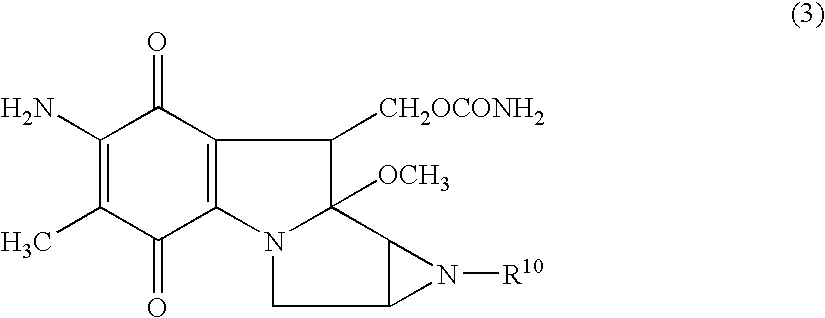Novel antibody conjugates reactive with human carcinomas
a technology of human carcinoma and antibody conjugates, which is applied in the field of murine monoclonal antibodies and chimeric monoclonal antibodies, can solve the problems of inconvenient preparation of conjugates with antitumor drugs or toxins, anti-transferrin-receptor antibodies in antibody-drug or antibody-toxin conjugates that may have significant toxic effects on normal cells, and the utility of this antibody for selective killing or inhibition of tumor cells is questionabl
- Summary
- Abstract
- Description
- Claims
- Application Information
AI Technical Summary
Problems solved by technology
Method used
Image
Examples
preparation 1
2,5-Dihydro-2,5-Dioxo-1H-Pyrrolo-1-Hexanoic Acid Hydrazide and its Trifluoroacetic Acid Salt (“Maleimidocaproyl Hydrazide”)
[0283] Maleimidocaproic acid (2.11 g, 10 mmol) [see, e.g., D. Rich et al., J. Med. Chem., 18, 1004 (1975) and, O. Keller, et al., Helv. Chim. Acta, 58 531 (1975)] was dissolved in dry tetrahydrofuran (200 mL) The solution was stirred under nitrogen, cooled to 4° C. and treated with N-methylmorpholine (1.01 g, 10 mmol) followed by dropwise addition of a solution of isobutyl chloroformate (1.36 g, 10 mmol) in THF (10 mL). After 5 min a solution of t-butyl carbazate (1.32 g, 10 mmol) in THF (10 mL) was added dropwise. The reaction mixture was kept at 4° C. for a half hour and at room temperature for 1 hour. The solvent was evaporated and the residue partitioned between ethyl acetate and water. The organic layer was washed with dilute HCl solution, water and dilute bicarbonate solution, dried over anhydrous sodium, sulfate and the solvent evaporated. The material w...
preparation 2
Maleimidocaproylhydrazone of Adriamycin
[0286] A mixture of adriamycin hydrochloride (44 mg, 0.075 mmol), maleimidocaproyl hydrazide (23 mg, 0.102 mmol), prepared according to the procedure outlined in Preparation 1, and 2-3 drops of trifluoroacetic acid in absolute methanol (25 mL) was stirred or 15 hours under nitrogen and protected from light. At the end of this period no free adriamycin was detected by HPLC (mobile phase 0.01 molar ammonium acetate:acetonitrile, (70:30)). The solution was concentrated at room temperature under vacuum to 10 mL and diluted with acetonitrile. The clear solution was concentrated to a small volume, the solid was collected by centrifugation, and the product was dried under high vacuum to yield the title compound. The NMR was consistent with structure. High Resolution MS, calc'd. for C33H42N4O13: 751.2827; Found 757 2804.
[0287] The hydrazone also was formed by using adriamycin and the trifluoroacetic acid salt of the hydrazide. Thus, the salt (40 mg, ...
example 1
Preparation of the BR96 Monoclonal Antibody
[0345] The BR96 monoclonal antibody of the invention was produced using hybridoma fusion techniques as described previously by M. Yeh et al., Proc. Natl. Acad. Sci. USA. (1979), supra and Yeh et al., Int. J. Cancer (1982), supra. Briefly, a three month-old BALB / c mouse was immunized using as the immunogen explanted cultured cells from a human breast adenocarcinoma, designated 3396 or H3396 (from adenocarcinoma of the breast from a patient which had been established in culture at Bristol-Myers Squibb Co., Seattle, Wash.). Methods for establishing and maintaining cell lines from carcinomas isolated from patients are fully described in Yeh et al., Proc. Natl. Acad. Sci. USA 76:2927-2931 (1979) The mouse received injections on five occasions: on the first four occasions, the mouse received one intraperitoneal injection and 1 subcutaneous injection split between 4 sites on the mouse. On the fifth occasion, the mouse was given only one intraper...
PUM
| Property | Measurement | Unit |
|---|---|---|
| concentrations | aaaaa | aaaaa |
| concentrations | aaaaa | aaaaa |
| concentration | aaaaa | aaaaa |
Abstract
Description
Claims
Application Information
 Login to View More
Login to View More - R&D
- Intellectual Property
- Life Sciences
- Materials
- Tech Scout
- Unparalleled Data Quality
- Higher Quality Content
- 60% Fewer Hallucinations
Browse by: Latest US Patents, China's latest patents, Technical Efficacy Thesaurus, Application Domain, Technology Topic, Popular Technical Reports.
© 2025 PatSnap. All rights reserved.Legal|Privacy policy|Modern Slavery Act Transparency Statement|Sitemap|About US| Contact US: help@patsnap.com



